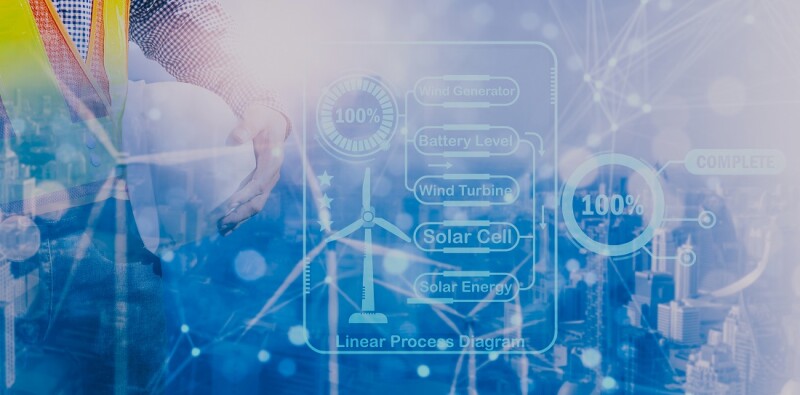Renewable energy sources, including solar, wind, hydroelectric, and biomass, made up approximately 30% of the total electricity generated globally; that total is 20% in the United States. As of 2022, hydroelectric power is the most common source of renewable energy globally, with an installed capacity greater than 1,200 GW. In comparison, more than 600,000 wind turbines are operating globally, with a combined capacity greater than 600 GW. Wind energy was the fastest-growing source of electricity globally, with a growth rate of 15%, while solar energy was the fastest-growing source of electricity in the United States, with a growth rate of 27%. China is the world’s largest producer of solar energy, followed by the United States and India.
The use of artificial intelligence (AI) in the clean energy sector increases the availability and accessibility of clean energy, making it a more viable and cost-effective alternative to traditional energy sources. Here are few broad areas where AI is boosting the clean energy transition.
Exploration and Planning
AI improves the efficiency and cost-effectiveness of discovering and extracting clean energy. For example, AI is used to analyze large data sets from satellite imagery, sensor networks, and other sources to identify the most promising locations for renewable energy projects such as solar farms, wind farms, geothermal plants, and hydroelectric dams. AI predicts the likely performance of clean energy projects based on factors such as weather conditions, land use, and the availability of resources, allowing companies to make more informed decisions about where to invest. AI helps create detailed hydroelectric and geothermal reservoir models, which are typically used for identifying the most efficient site locations and for designing the operational infrastructure for the most effective extraction of clean energy. AI has been implemented in planning the placement and orientation of clean energy systems, such as solar panels and wind turbines, to maximize their energy production.
Performance Optimization
Environmental impacts of excessive energy use can be reduced significantly through performance optimization of the clean-energy systems. AI is used to optimize the energy usage of electric vehicles (EVs) by predicting the most efficient route to a destination. Using the data on traffic and weather conditions, AI adjusts the vehicle’s energy consumption. Furthermore, AI optimizes battery charging in EVs by predicting the best times to charge based on factors such as electricity prices and availability. In the case of solar panels and wind turbines, AI improves the performance by predicting when the panels and turbines will be most efficient and adjusting their angle to maximize the amount of sunlight and wind they receive. Similar performance enhancements have been demonstrated in geothermal energy where AI tunes the performance of geothermal power plants by adjusting the flow rate of the geothermal reservoir to maximize energy production while ensuring sustainable heat extraction with limited environmental footprint. Along those lines, the flow rates of coolant and of water are adaptively controlled by AI to refine the nuclear and hydroelectric power-plant performances, respectively.
Energy Production Forecasting
For a smooth and timely energy transition, energy production forecasting is an important tool. This helps energy companies plan for the future by predicting how much clean energy will be available and what their energy mix and infrastructure investments should be. Accurate clean-energy production forecasting can help energy companies reduce costs and downtime by avoiding overproduction or underproduction of clean energy. AI helps analyze data from a variety of sources, including weather forecasts, satellite imagery, and sensor networks, to predict the likely performance of clean energy sources. AI is crucial for real-time predictive as well as preemptive maintenance needs, improving the reliability and predictability of clean energy sources. AI helps prevent downtime and ensures that clean energy sources are operating at their maximum capacity. Overall, the use of AI in clean energy production forecasting improves the accuracy and reliability of energy production forecasts, allowing energy companies to make more informed decisions about their energy transition strategies.
Safety
AI is needed in the clean energy sector to improve safety by predicting and preventing issues while ensuring timely maintenance and emergency response. For example, AI has been used in real-time monitoring of structural integrity of wind turbines and the temperature of solar panels to identify potential problems before they cause damage or failure. AI facilitates the on-time maintenance and repair of clean energy systems, reducing the risk of accidents and downtime, while improving overall safety. AI is also being deployed for predicting the likelihood of natural disasters such as earthquakes and hurricanes and optimize the response to these events to minimize the damage to clean energy systems. AI can predict when EV batteries and other components will need maintenance or repair, allowing for proactive rather than reactive maintenance.
Waste Management and Recycling
AI is routinely used to predict the likely lifespan of clean energy systems and optimize the timing of their decommissioning and recycling. AI can be used to optimize the recycling of materials used in clean energy systems, such as solar panels, wind turbines, and hydroelectric dams, by identifying the most valuable materials in these systems and then determining the most efficient recycling processes. In nuclear waste management, AI can help design the most efficient methods of storage and disposal.
Overall, the use of artificial intelligence in the clean energy sector has the potential to greatly increase access to renewable resources and reduce reliance on fossil fuels. This is not only good for the environment but also can lead to cost savings for consumers and businesses. By analyzing data and predicting demand, AI can help ensure that clean energy is delivered to where it is needed most, reducing waste and increasing access. This is an exciting time for the clean energy industry, and AI is sure to play a key role in its continued growth and success.


